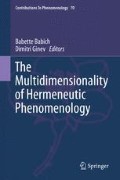Abstract
Geology has had a marginal place within the philosophy of science; its processes and results have not matched our traditional ideas concerning the nature and outcomes of scientific reasoning. This is a reflection of the fact that philosophy of science has been, with few exceptions, implicitly or explicitly the philosophy of physics, and more generally the philosophy of lab science. In actuality, geological reasoning provides a rich and realistic account of the power and limitations of scientific reasoning. It also highlights the hermeneutic and historical nature of reasoning, scientific or otherwise, and the neglected kinship between reasoning in the sciences and the humanities.
Access this chapter
Tax calculation will be finalised at checkout
Purchases are for personal use only
Notes
- 1.
- 2.
Cf. Laudan (1987).
- 3.
- 4.
- 5.
Nelson Goodman (1967).
- 6.
But see Cervato and Frodeman (2012).
- 7.
- 8.
- 9.
Doreen Massey (1999).
- 10.
Leiter 2007.
- 11.
Martin J. S. Rudwick (1976).
- 12.
Maurice Merleau-Ponty (1993).
- 13.
Martin Heidegger (1962).
- 14.
- 15.
Paul A. David (2000).
- 16.
Cf. Nancy Cartwright (1983).
- 17.
Hull (1976).
- 18.
Ivo Lucchitta (1990).
- 19.
Hayden White (1963).
- 20.
Naomi Oreskes (2000).
- 21.
References
Ager, Derek V. 1993. The nature of the stratigraphical record. Chichester: Wiley.
Babich, Babette. 2010. Towards a critical philosophy of science: Continental beginnings and bugbears, whigs and waterbears. International Journal of the Philosophy of Science 24(4): 343–391.
Babich, Babette. 2013. Early continental philosophy of science. In The new century: Bergsonism, phenomenology, and responses to modern science, ed. K. Ansell-Pearson and Alan Schrift, 263–286. Durham: Acumen.
Bechtel, W., and M. Herschbach. 2010. Philosophy of the cognitive sciences. In Philosophy of the sciences, ed. Fritz Allhoff, 237–261. Oxford: Blackwell.
Cartwright, Nancy. 1983. How the laws of physics lie. Oxford: Oxford University Press.
Cervato, Cinzia, and Robert Frodeman. 2012. The significance of geologic time. Earth in mind, II, GSA special volume.
Chamberlin, T.C. 1890. The method of multiple working hypotheses. Science 15: 92–96.
David, Paul A. 2000. Path dependence, its vritics and the quest for historical economics. In Evolution and path dependence in economic ideas: Past and present, ed. P. Garrouste and S. Ioannides. Cheltenham: Edward Elgar Publishing.
Eldredge, Niles. 1995. Dominion. New York: H. Holt.
Engelhardt, W.V., and J. Zimmermann. 1988 [1982]. Theory of earth science. New York: Cambridge University Press.
Frodeman, Robert. 1995. Geological reasoning: Geology as an interpretive and historical science. GSA Bulletin 107: 960–968.
Frodeman, Robert. 2003. Geologic: Breaking ground between philosophy and the earth sciences. Albany: State University of New York Press.
Frodeman, Robert. 2010. Experiments in field philosophy. New York Times. November 23.
Frodeman, Robert. 2013. Philosophy dedisciplined. Synthese 190(11): 1917–1936. July 2013.
Giere, Ronald N. 1988. Explaining science: A cognitive approach. Chicago: University of Chicago Press.
Gilbert, G.K. 1886. The inculcation of scientific method by example. American Journal of Science 31: 284–299. 3rd ser.
Goodman, Nelson. 1967. Uniformity and simplicity. In Uniformity and simplicity: A symposium on the principle of the uniformity of nature, New York: Geological society of America special paper, vol. 89, ed. C.C. Albritton Jr. et al., 93–99.
Gould, Stephen Jay. 1997. Time’s arrow, time’s cycle. Cambridge, MA: Harvard University Press.
Harré, Rom. 2000. Philosophy and geology. In The Oxford companion to the Earth, ed. P. Hancock and B.J. Skinner, 821–822. Oxford: Oxford University Press.
Heidegger, Martin. 1962. Being and Time. Trans. John, MacQuarrie, and Edward, Robinson. London: SCM Press.
Hull, D.L. 1976. Central subjects and historical narratives. History and Theory 14: 253–274.
Inkpen, Robert John. 2009. The philosophy of geology. In A companion to the philosophy of history and historiography, ed. A. Tucker, 318–329. Chichester: Wiley-Blackwell.
Kitts, David B. 1977. The structure of geology. Dallas: SMU Press.
Knorr-Cetina, Karin. 1999. Epistemic cultures: How the sciences make knowledge. Cambridge: Harvard University Press.
Lauden, Rachel. 1987. From mineralogy to geology: The foundations of a science, 1650–1830. Chicago: University of Chicago Press.
Leiter, Brian. 2007. The future for philosophy. Oxford: Oxford University Press.
Lucchitta, Ivo. 1990. The history of the Colorado river and the Grand Canyon. In Grand Canyon geology, ed. Stanley Beus and Michael Morales. Flagstaff: Museum of Northern Arizona Press.
Massey, Doreen. 1999. Space-time, science, and the relationship between physical geography and human geography. Institute of British Geography 24: 264.
McPhee, John. 1981. Basin and range. New York: Farrar, Straus and Giroux.
McPhee, John. 1983. In suspect terrain. New York: Farrar, Straus and Giroux.
Merleau-Ponty, Maurice. 1993. Eye and mind. In: The Merleau-Ponty Aesthetics Reader, ed. Galen A. Johnson (trans: Michael B. Smith). Evanston: Northwestern University Press.
Oreskes, Naomi. 2000. Why predict? Historical perspectives on prediction in Earth science. In Prediction: Science, decision making, and the future of nature, ed. Sarewitz Daniel, Roger A. Pielke Jr, and Radford Byerly Jr., 23–40. Washington, DC: Island Press.
Oreskes, Naomi, Kristin Shrader-Frechette, and Kenneth Belitz. 1994. Verification, validation, and confirmation of numerical models. Science 263(5147): 641–646. Feb 4 1994.
Pickering, Andrew (ed.). 1992. Science as practice and culture. Chicago: University of Chicago Press.
Rudwick, Martin J.S. 1976. The emergence of a visual language for geological science, 1760-1840. History of Science 14: 149–195.
Schumm, Stanley A. 1991. To interpret the Earth. New York: Cambridge University Press.
Ward, Peter D. 1998. Time machines: Scientific explorations in deep time. New York: Copernicus.
White, Hayden. 1963. The logic of historical narration. Philosophy and History 3: 4–14.
Wilson, Edward O. 1998. Consilience: The unity of knowledge. New York: Knopf.
Author information
Authors and Affiliations
Corresponding author
Editor information
Editors and Affiliations
Rights and permissions
Copyright information
© 2014 Springer International Publishing Switzerland
About this chapter
Cite this chapter
Frodeman, R. (2014). Hermeneutics in the Field: The Philosophy of Geology. In: Babich, B., Ginev, D. (eds) The Multidimensionality of Hermeneutic Phenomenology. Contributions to Phenomenology, vol 70. Springer, Cham. https://doi.org/10.1007/978-3-319-01707-5_5
Download citation
DOI: https://doi.org/10.1007/978-3-319-01707-5_5
Published:
Publisher Name: Springer, Cham
Print ISBN: 978-3-319-01706-8
Online ISBN: 978-3-319-01707-5
eBook Packages: Humanities, Social Sciences and LawPhilosophy and Religion (R0)

